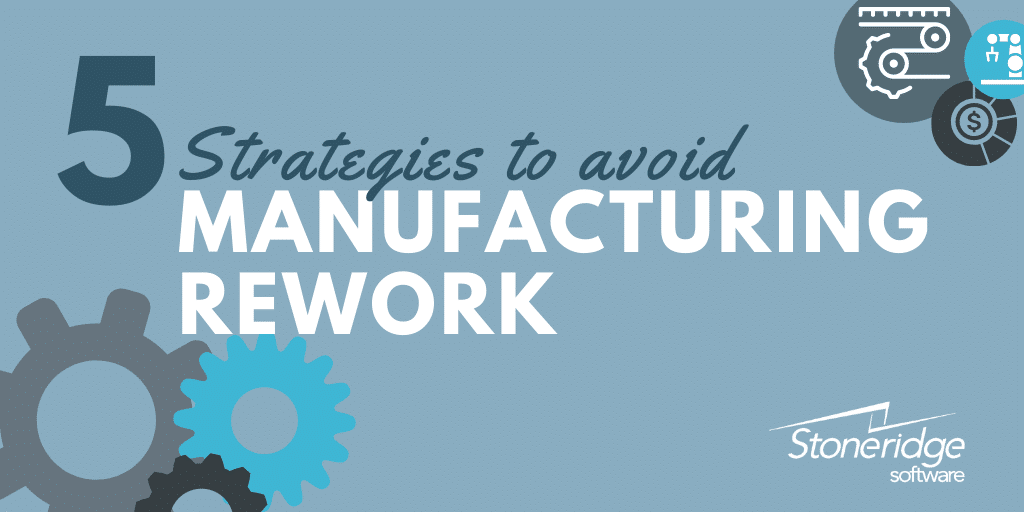Five Key Strategies for Reducing Manufacturing Rework
The manufacturing rework process costs time and money and leads to increased production time and expenses. Production rework can be reduced, or nearly eliminated, by implementing strategies for production success.
1. Design, Testing, and ERP
Dedicating time to design, testing, and ERP requirements are the first step to reducing manufacturing rework. As your engineers develop their initial design, information from CAD, or other design programs, should be integrated with Dynamics 365 to complete the design iteration and understand what materials are needed and the machine requirements and capabilities. The system will generate a Bill of Materials that can help inform what specifically is needed to complete the production of the item.
This step ensures that you have a good structure in place to validate fit, form, and function of a part prior to it entering the production lifecycle.
2. Shop Floor Execution
Another step in the testing process is ensuring the shop floor can execute production accurately and efficiently. The Bill of Materials generated in Dynamics 365 includes work instructions and documentation from the engineers. Share this information with the shop floor to ensure the work instructions are accurate and detailed enough for production, and supplemental information is available within the system when additional information on each step is needed.
Assess your instructions to ensure:
- They aren’t overly complex
- Each step is spaced out logically between users in production
- Production team has the right information to produce the part accurately
During this step, test the production process at a small scale to ensure that not only are the instructions and BOM accurate on paper, but also in action. Once the process has been tested, engineering revisions or changes can be made and re-tested prior to launching the full production process.
This concept and testing stage is critical to success.
3. Quality Control
This stage can frequently be overlooked in order to speed up production and save on costs. However, in order to truly reduce production rework, this stage should be completed for each new item you introduce to the production line.
When manufacturing a new item or part, you need to consider the aspects of humans, tooling, and learning. Each area includes a learning curve where initially there may be errors that occur – some of which you may not initially be aware of.
After each production line operation for initial parts, set up an aggressive quality control system and follow quality metrics. Manufacturers who do the best at eliminating rework thrive in this stage of quality control. Using Dynamics 365, you can identify where any issues are occurring, and the system can help you identify other areas in the process where errors are likely to happen based on similarities.
This helps you not only identify issues immediately but also predict and be proactive to other possible problem areas.
4. Open Lines of Communication
This stage separates good manufacturers from great manufacturers. Communication to and from your production line to your engineers is important in any manufacturing environment, but communication from your customers is equally, or even more, important.
While your testing strategy can identify defects in manufacturing, your consumers are better equipped to report on the use and environmental issues that impact quality. Gathering and tracking feedback is simple with a PowerApps Portal that directly integrates with Dynamics 365. Your consumers can fill out a customized form to report issues or give feedback, and that information is gathered, sorted and consolidated within the system for review. Manufacturing field service technicians can use this same portal to report information back.
Vehicle manufacturers frequently use this strategy to alter production requirements. For example, the first version of a car is typically over-engineered to avoid issues. As feedback is collected from customers and road use case information is compiled, engineers can make changes and start to reduce the product requirements once they have evidence to determine which parts can be downgraded, which need higher quality, etc.
5. Think about the Future
Technology is progressing at a rapid rate and the best time to plan for the future is now. With new strategies, manufacturers are able to produce products that are of higher quality in a shorter amount of time.
Strategies for the future of your operation:
- Subtractive manufacturing
- Additive manufacturing
- Machine Learning
- Artificial Intelligence and Internet of Things (IoT)
Data is key to driving manufacturing updates and changes. Even a new part design can be driven by data insights. For example, data may indicate that a standard bracket breaks down after a period of time due to stress on the item. Using that information, you can use technology to redesign that same bracket in a non-symmetrical way to avoid wear and breakdowns.
By implementing these strategies and investing in a leading-edge manufacturing solution like Dynamics 365, you’ll reduce or eliminate unnecessary manufacturing re-work and produce higher quality products at a lower overall cost.
Learn more by reaching out to the manufacturing experts at Stoneridge Software.
Under the terms of this license, you are authorized to share and redistribute the content across various mediums, subject to adherence to the specified conditions: you must provide proper attribution to Stoneridge as the original creator in a manner that does not imply their endorsement of your use, the material is to be utilized solely for non-commercial purposes, and alterations, modifications, or derivative works based on the original material are strictly prohibited.
Responsibility rests with the licensee to ensure that their use of the material does not violate any other rights.

